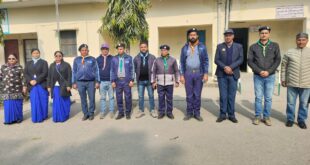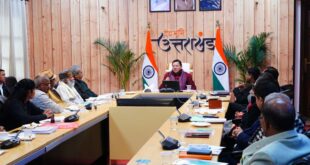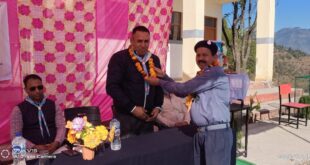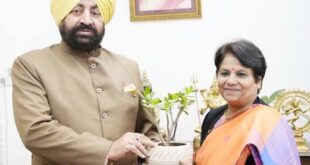Chief Minister of Uttarakhand inaugurated a newly constructed building of PM Shri Kendriya Vidyalaya (KV) Khatima on 29 July 2025 which cost Rs 26.23 crore to the Central Government. He averred in his speech that if this KV existed during his childhood, he would have studied there. Head of the state Government making such statement speaks volumes about the standard of Kendriya Vidyalayas. This transformation took time and efforts to evolve in it’s present form and still undergoing through the process of evolution.
Author served in different KVs as a Post Graduate Teacher (PGT) in Physics for a period of nearly seven years before joining the present assignment. Credit of big reforms in KVS functioning goes to HM Caire, IAS (now retired) who took over as KVS Commissioner in 1999. As an incumbent, he changed the recruitment process by making written tests compulsory at all levels and giving opportunities to all who met minimum educational qualification unlike the practice then in which only few candidates who stood above the cutoff points were called for direct interviews. This step brought ray of hope for those candidates whose academic credentials were not very strong but their conceptual clarity of the subject was good. This helped develop a deserving teachers’ force that were ready to deliver their best. I was lucky enough to get an opportunity for appearing in written exam and clearing it. Prior to it, I applied three times but was never called for interview. At the same time he built up a system of deliverance in which everyone in the chain of command was made responsible for the students’ performance be it in Academics, Sports, Science /Social Science exhibitions etc. This decree helped getting full involvement of teachers in the holistic development of their disciples. Those who did not fall in line either quit service voluntarily or were forced to do so. Teachers prepared study materials and question banks catering to the needs of all categories of students i.e. intelligent ones, average performers and under achievers. Extra classes for the needy ones were arranged and periodic testing mechanism was developed. Goals of achieving learning outcomes in the form of results of Board and internal examinations were set. Analysis of quantitative results (pass percentage) and qualitative results (Performance Indicator or PI) was carried out at regional levels and accordingly need based teachers training programmes were organized for improving the content delivery and hence improving the assimilation level of students. Through these programmes teachers were trained to make the topics lucid for the students and the question banks were developed according to the CBSE pattern using NCERT books. Periodic assessment and counselling sessions of teachers were carried out and on the basis of the appraisal, the under performers were either warned or penalized in terms of withholding the annual increments or awarding punishment postings to priority areas (hard stations). Initially there was an all-round hue and cry due to this unprecedented action but soon it became part of the system. Though I believe in the principle of giving academic freedom to the teachers for better content delivery and yielding good results in the end but this top down approach in the KVS functioning became beneficial for the students. Such were the rigours of the system that the author despite being on paternity leave (PL) after birth of daughter, attended the school regularly to take extra classes for slow learners who were to appear in the class 12 Board examination braving the ire of beloved wife who was in need of assistance throughout the day and night then. My daughter had undergone major surgery at All India Institute of Medical Sciences (AIIMS) New Delhi after few months of her birth and was on observation while recuperating post-surgery. So doctors advised us to remain near the AIIMS for few days but I left to join back duty at the school after making some alternative arrangements so that students’ academic classes did not suffer.
In view of better upkeep of the schools’ premises and to mete out petty expenses, Rs 100 per month were added in the school fee in the form of Vidyalaya Vikas Nidhi (VVN) and Principals were authorized to make the best use of the corpus thus generated. School’s security staff and sanitation staff were hired from this fund and other expenditures including achievement awards for students, infrastructural maintenance etc. were also managed. Students were exposed to various outdoor activities including trekking and excursions. Such initiatives not only improved the academic environment of the schools, it made students well versed with co-curricular and extra-curricular activities too. Now a day, getting admission in a KV is not as easy as it used to be in the past. Moreover the admission procedure is transparent and there is minimum or no scope of tampering with it.
In Uttarakhand, state schools are totally funded by the state Government with free education at primary level, nominal fee for boys at secondary level and free education for girls at both primary and secondary levels. Uttarakhand has allocated 16.8% of its expenditure on education which is 2.1% higher than the previous year’s budgetary allocation. As, major chunk of this budget (more than 80%) is spent on the pay and perks of the staff, leaving behind a small fund for the infrastructural development and maintenance. For this purpose state seeks help from the centre and philanthropists as well. Central Government allotted Rs 1205 crore for year 2023-24 and 750 crore for the year 2024-25 under Samagra Shiksha Abhiyan (SSA) scheme, of which 33% is allocated for infrastructure development and maintenance and rest 67% for academics that include purchasing books, organizing education fairs, organizing remedial classes and other related activities. With meagre sum in hand and vested interests galore quality of work is often compromised that results into speedy damage of the infrastructure. As a result of it as many as 145 primary schools spread over 11 districts are being run on rental houses as their school buildings are in dilapidated state and Government has asked school education department to conduct a comprehensive safety audit of the school buildings learning lesson from recent school building collapse in Rajasthan resulting into fatalities. Government is inviting corporate sectors to support the infrastructure development in the schools and 550 corporate houses such as IGL, Relaxo Footwear, Convegenius, Taj group, Gondwana research etc and Uttarakhand diaspora has given their consent is a welcome move.
Dwindling students’ strength and shortage of teachers add woes to agony to the existing rickety system that demands major overhauling. Many parents are sending their wards to the Public schools, which yield better results and good exposure to co-curricular activities albeit with underpaid teaching and support staff. Author studied in the Government schools of Bhatwari (Taknor) district Uttarkashi since primary level to class 12th affiliated to UP Board. Resources were scarce as well then but commitment of the teachers was paramount. I remember playing sports such as Baseball and Handball way back in 1983 when our Physical Training Instructor (PTI) who was incidentally my beloved father, went to see Asiad 1982 to New Delhi and purchased the mentioned sports’ kits for us and prepared play grounds for those sports also. Additionally he was the Teacher-Incharge for running a school owned book shop. The books and stationery were sold on subsidised rates to the students and profit of the sales was utilized for meeting infrastructural and other requirements of the school. When Approach Bridge to our school (Government Inter College Bhatwari Taknor Uttarkashi) was damaged during massive flood in Bhagirathi in 1978, he went to the school from a trolley which was around 08 kms away and then took jungle route to reach the school. All the books were transferred through a luggage trolley over river Bhagirathi in Bhatwari and the same were distributed to the students and the school was also run smoothly in the Primary school building. Our science teacher US Negi regularly took us to science labs, made us learn dissection of the frog at class 10th level, Hindi teacher HP Bahuguna made us efficient in Hindi and Sanskrit both. I started learning English from class six but soon developed interest in it thanks to our English teachers. Few instances mentioned here will help inspire the teaching faculty of modern times to do the same and yield good results. Though, there are some dedicated teachers present these days also, who are doing yeoman’s service. Clustering of schools with provision of transport facility in the first phase, hostel facility in the second phase and staff quarters in the third phase will help improve the strength of students, quality of education and employment generation opportunities for the locals residing in the vicinity of cluster schools. Strict monitoring, good governance and zeal to deliver are the need of the hour if authorities are really serious in improving the conditions of state schools and turning them to produce future nation builders. VVN should be made integral part of the school fee and for the wards of below poverty line (BPL) category; contribution should be made by the Government. Responsibility should be fixed in the chain of command for producing qualitatively and quantitatively good results and for not delivering satisfactorily in the respective fields, everyone in the chain of command from top to bottom should own responsibility and face the consequences as per procedures.
I hope with more sincerity at Government’s end, deliverance from the Education department and active contribution of parents, future of the students studying in Government schools will see some ray of hope and parents will send their wards to these schools enthusiastically as is the case in KVs.
Dr Prashant Thapliyal
Associate Professor
Army Cadet College IMA Dehradun
Ex PGT KVS
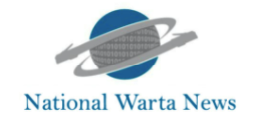 National Warta News
National Warta News
